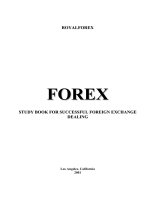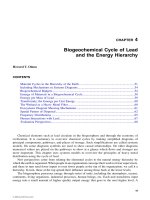Forex On-Line Manual For Successful Trading Chapter 4 doc
Bạn đang xem bản rút gọn của tài liệu. Xem và tải ngay bản đầy đủ của tài liệu tại đây (87.63 KB, 13 trang )
FOREX. On-line Manual For Successful Trading 32
CHAPTER 4
Fundamental Analysis
Two types of analysis are used for the market movements forecasting:
fundamental, and technical (the chart study of past behavior of commodity
prices). The fundamental one focuses on the theoretical models of exchange
rate determination and on the major economic factors and their likelihood of
affecting the foreign exchange rates.
4.1. Economic Fundamentals
Theories of Exchange Rate Determination
Fundamentals may be classified into economic factors, financial factors,
political factors, and crises. Economic factors differ from the other three
factors in terms of the certainty of their release. The dates and times of
economic data release are known well in advance, at least among the
industrialized nations. Below are given briefly several known theories of
exchange rate determination.
Purchasing Power Parity
Purchasing power parity states that the price of a good in one country
should equal the price of the same good in another country, exchanged at the
current rate—the law of one price. There are two versions of the purchasing
power parity theory: the absolute version and the relative version. Under the
absolute version, the exchange rate simply equals the ratio of the two
countries' general price levels, which is the weighted average of all goods
produced in a country. However, this version works only if it is possible to find
two countries, which produce or consume the same goods. Moreover, the
absolute version assumes that transportation costs and trade barriers are
insignificant. In reality, transportation costs are significant and dissimilar
around the world.
Trade barriers are still alive and well, sometimes obvious and
sometimes hidden, and they influence costs and goods distribution.
Finally, this version disregards the importance of brand names. For
example, cars are chosen not only based on the best price for the same type
of car, but also on the basis of the name ("You are what you drive").
FOREX. On-line Manual For Successful Trading 33
The PPP Relative Version
Under the relative version, the percentage change in the exchange rate
from a given base period must equal the difference between the percentage
change in the domestic price level and the percentage change in the foreign
price level. The relative version of the PPP is also not free of problems: it is
difficult or arbitrary to define the base period, trade restrictions remain a real
and thorny issue, just as with the absolute version, different price index
weighting and the inclusion of different products in the indexes make the
comparison difficult and in the long term, countries' internal price ratios may
change, causing the exchange rate to move away from the relative PPP.
In conclusion, the spot exchange rate moves independently of relative
domestic and foreign prices. In the short run, the exchange rate is influenced
by financial and not by commodity market conditions.
Theory of Elasticities
The theory of elasticities holds that the exchange rate is simply the
price of foreign exchange that maintains the balance of payments in
equilibrium. For instance, if the imports of country A are strong, then the
trade balance is weak. Consequently, the exchange rate rises, leading to the
growth of country A's exports, and triggers in turn a rise in its domestic
income, along with a decrease in its foreign income. Whereas a rise in the
domestic income (in country A) will trigger an increase in the domestic
consumption of both domestic and foreign goods and, therefore, more
demand for foreign currencies, a decrease in the foreign income (in country
B) will trigger a decrease in the domestic consumption of both country B's
domestic and foreign goods, and therefore less demand for its own currency.
The elasticities approach is not problem-free because in the short term
the exchange rate is more inelastic than it is in the long term and the
additional exchange rate variables arise continuously, changing the rules of
the game.
Modern Monetary Theories on Short-Term Exchange Rate Volatility
The modern monetary theories on short-term exchange rate volatility
take into consideration the short-term capital markets' role and the long-term
impact of the commodity markets on foreign exchange. These theories hold
that the divergence between the exchange rate and the purchasing power
parity is due to the supply and demand for financial assets and the
international capability.
One of the modern monetary theories states that exchange rate
volatility is triggered by a one-time domestic money supply increase, because
this is assumed to raise expectations of higher future monetary growth.
The purchasing power parity theory is extended to include the capital
markets. If, in both countries whose currencies are exchanged, the demand
FOREX. On-line Manual For Successful Trading 34
for money is determined by the level of domestic income and domestic
interest rates, then a higher income increases demand for transactions
balances while a higher interest rate increases the opportunity cost of holding
money, reducing the demand for money.
Under a second approach, the exchange rate adjusts instantaneously to
maintain continuous interest rate parity, but only in the long run to maintain
PPP.
Volatility occurs because the commodity markets adjust more slowly
than the financial markets. This version is known as the dynamic monetary
approach.
The Portfolio-Balance Approach
The portfolio-balance approach holds that currency demand is triggered
by the demand for financial assets, rather than the demand for the currency
per se.
Synthesis of Traditional and Modern Monetary Views
In order to better suit the previous theories to the realities of the
market, some of the more stringent conditions were adjusted into a synthesis
of the traditional and modern monetary theories.
A short-term capital outflow induced by a monetary shock creates a
payments imbalance that requires an exchange rate change to maintain
balance of payments equilibrium. Speculative forces, commodity markets
disturbances, and the existence of short-term capital mobility trigger the
exchange rate volatility. The degree of change in the exchange rate is a
function of consumers' elasticity of demand.
Because the financial markets adjust faster than the commodities
markets, the exchange rate tends to be affected in the short term by capital
market changes, and in the long term by commodities changes.
FOREX. On-line Manual For Successful Trading 35
4.2. Economic Indicators
Economic indicators occur in a steady stream, at certain times, and a
little more often than changes in interest rates, governments, or natural
activity such as earthquakes etc. Economic data is generally (except of the
Gross Domestic Product and the Employment Cost Index, which are released
quarterly) released on a monthly basis.
All economic indicators are released in pairs. The first number reflects
the latest period. The second number is the revised figure for the month prior
to the latest period. For instance, in July, economic data is released for the
month of June, the latest period. In addition, the release includes the revision
of the same economic indicator figure for the month of May. The reason for
the revision is that the department in charge of the economic statistics
compilation is in a better position to gather more information in a month's
time. This feature is important for traders. If the figure for an economic
indicator is better than expected by 0.4 percent for the past month, but the
previous month's number is revised lower by 0.4 percent, then traders are
likely to ignore the overall release of that specific economic data.
Economic indicators are released at different times. In the United
States, economic data is generally released at 8:30 and 10 am ET. It is
important to remember that the most significant data for foreign exchange is
released at 8:30 am ET. In order to allow time for last-minute adjustments,
the United States currency futures markets open at 8:20 am ET.
Information on upcoming economic indicators is published in all leading
newspapers, such as the Wall Street Journal, the Financial Times, and the
New York Times; and business magazines, such as Business Week. More
often than not, traders use the monitor sources—Bridge Information Systems,
Reuters, or Bloomberg—to gather information both from news publications
and from the sources' own up-to-date information.
The Gross National Product (GNP)
The Gross National Product measures the economic performance of the
whole economy.
This indicator consists, at macro scale, of the sum of consumption
spending, investment spending, government spending, and net trade. The
gross national product refers to the sum of all goods and services produced
by United States residents, either in the United States or abroad.
The Gross Domestic Product (GDP)
The Gross Domestic Product (GDP) refers to the sum of all goods and
services produced in the United States, either by domestic or foreign
companies. The differences between the two are nominal in the case of the
economy of the United States. GDP figures are more popular outside the
FOREX. On-line Manual For Successful Trading 36
United States. In order to make it easier to compare the performances of
different economies, the United States also releases GDP figures.
Consumption Spending
Consumption is made possible by personal income and discretionary
income. The decision by consumers to spend or to save is psychological in
nature. Consumer confidence is also measured as an important indicator of
the propensity of consumers who have discretionary income to switch from
saving to buying.
Investment Spending
Investment—or gross private domestic spending - consists of fixed
investment and inventories.
Government Spending
Government spending is very influential in terms of both sheer size and
its impact on other economic indicators, due to special expenditures. For
instance, United States military expenditures had a significant role in total
U.S. employment until 1990. The defense cuts that occurred at the time
increased unemployment figures in the short run.
Net Trade
Net trade is another major component of the GNP. Worldwide
internationalization and the economic and political developments since 1980
have had a sharp impact on the United States' ability to compete overseas.
The U.S. trade deficit of the past decades has slowed down the overall GNP.
GNP can be approached in two ways: flow of product and flow of cost.
Industrial Production
Industrial production consists of the total output of a nation's plants,
utilities, and mines. From a fundamental point of view, it is an important
economic indicator that reflects the strength of the economy, and by
extrapolation, the strength of a specific currency. Therefore, foreign exchange
traders use this economic indicator as a potential trading signal.
Capacity Utilization
Capacity utilization consists of total industrial output divided by total
production capability. The term refers to the maximum level of output a plant
can generate under normal business conditions. In general, capacity
utilization is not a major economic indicator for the foreign exchange market.
However, there are instances when its economic implications are useful
for fundamental analysis. A "normal" figure for a steady economy is 81.5
percent. If the figure reads 85 percent or more, the data suggests that the
industrial production is overheating, that the economy is close to full capacity.
High capacity utilization rates precede inflation, and expectation in the foreign
FOREX. On-line Manual For Successful Trading 37
exchange market is that the central bank will raise interest rates in order to
avoid or fight inflation.
Factory Orders
Factory orders refer to the total of durable and nondurable goods
orders. Nondurable goods consist of food, clothing, light industrial products,
and products designed for the maintenance of durable goods. Durable goods
orders are discussed separately. The factory orders indicator has limited
significance for foreign exchange traders.
Durable Goods Orders
Durable goods orders consist of products with a life span of more than
three years. Examples of durable goods are autos, appliances, furniture,
jewelry, and toys. They are divided into four major categories: primary
metals, machinery, electrical machinery, and transportation.
In order to eliminate the volatility pertinent to large military orders, the
indicator includes a breakdown of the orders between defense and non-
defense.
This data is fairly important to foreign exchange markets because it
gives a good indication of consumer confidence. Because durable goods cost
more than nondurables, a high number in this indicator shows consumers'
propensity to spend. Therefore, a good figure is generally bullish for the
domestic currency.
Business Inventories
Business inventories consist of items produced and held for future sale.
The compilation of this information is facile and holds little surprise for the
market. Moreover, financial management and computerization help control
business inventories in unprecedented ways. Therefore, the importance of
this indicator for foreign exchange traders is limited.
Construction Indicators
Construction indicators constitute significant economic indicators that
are included in the calculation of the GDP of the United States. Moreover,
housing has traditionally been the engine that pulled the U.S. economy out of
recessions after World War II. These indicators are classified into three major
categories:
1. housing starts and permits;
2. new and existing one-family home sales and
3. construction spending.
Private housing is monitored closely at all the major stages. (See Figure
4.1.) Private housing is classified based on the number of units (one, two,
three, four, five, or more); region (Northeast, West, Midwest, and South);
and inside or outside metropolitan statistical areas.
FOREX. On-line Manual For Successful Trading 38
Figure 4.1. Diagram of construction of private housing
Construction indicators are cyclical and very sensitive to the level of
interest rates (and consequently mortgage rates) and the level of disposable
income. Low interest rates alone may not be able to generate a high demand
for housing, though. As the situation in the early 1990s demonstrated, despite
historically low mortgage rates in the United States, housing increased only
marginally, as a result of the lack of job security in a weak economy.
Housing starts between one and a half and two million units reflect a
strong economy, whereas a figure of approximately one million units suggests
that the economy is in recession.
Inflation Indicators
The rate of inflation is the widespread rise in prices. Therefore, gauging
inflation is a vital macroeconomic task. Traders watch the development of
inflation closely, because the method of choice for fighting inflation is raising
the interest rates, and higher interest rates tend to support the local currency.
Moreover, the inflation rate is used to "deflate" nominal interest rates and the
GNP or GDP to their real values in order to achieve a more accurate measure
of the data.
The values of the real interest rates or real GNP and GDP are of the
utmost importance to the money managers and traders of international
financial instruments, allowing them to accurately compare opportunities
worldwide.
To measure inflation traders use following economic tools:
• Producer Price Index (PPI);
• Consumer Price Index (CPI);
• GNP Deflator;
• GDP Deflator;
• Employment Cost Index (ECI);
• Commodity Research Bureau's Index (CRB Index);
• Journal of Commerce Industrial Price Index (JoC).
FOREX. On-line Manual For Successful Trading 39
The first four are strictly economic indicators; they are released at
specific intervals. The commodity indexes provide information on inflation
quickly and continuously.
Other economic data that measure inflation are unemployment,
consumer prices, and capacity utilization.
Producer Price Index (PPI)
Producer price index is compiled from most sectors of the economy,
such as manufacturing, mining, and agriculture. The sample used to calculate
the index contains about 3400 commodities. The weights used for the
calculation of the index for some of the most important groups are: food - 24
percent; fuel - 7 percent; autos - 7 percent; and clothing - 6 percent. Unlike
the CPI, the PPI does not include imported goods, services, or taxes.
Consumer Price Index (CPI)
Consumer price index reflects the average change in retail prices for a
fixed market basket of goods and services. The CPI data is compiled from a
sample of prices for food, shelter, clothing, fuel, transportation, and medical
services that people purchase on daily basis. The weights attached for the
calculation of the index to the most important groups are: housing - 38
percent; food - 19 percent; fuel - 8 percent; and autos - 7 percent.
The two indexes, PPI and CPI, are instrumental in helping traders
measure inflationary activity, although the Federal Reserve takes the position
that the indexes overstate the strength of inflation.
Gross National Product Implicit Deflator
Gross national product implicit deflator is calculated by dividing the
current dollar GNP figure by the constant dollar GNP figure.
Gross Domestic Product Implicit
Gross domestic product implicit deflator is calculated by dividing the
current dollar GDP figure by the constant dollar GDP figure.
Both the GNP and GDP implicit deflators are released quarterly, along
with the respective GNP and GDP figures. The implicit deflators are generally
regarded as the most significant measure of inflation.
Commodity Research Bureau's Futures Index (CRB index)
The Commodity Research Bureau's Futures Index makes watching for
inflationary trends easier. The CRB Index consists of the equally weighted
futures prices of 21 commodities. The components of the CRB Index are:
• precious metals: gold, silver, platinum;
• industrials: crude oil, heating oil, unleaded gas, lumber, copper,
and cotton;
• grains: corn, wheat, soybeans, soy meal, soy oil;
FOREX. On-line Manual For Successful Trading 40
• livestock and meat: cattle, hogs, and pork bellies;
• imports: coffee, cocoa, sugar;
• miscellaneous: orange juice.
The preponderance of food commodities makes the CRB Index less
reliable in terms of general inflation. Nevertheless, the index is a popular tool
that has proved quite reliable since the late 1980s.
The “Journal of commerce” Industrial Price Index (JoC)
The “Journal of commerce” industrial price index consists of the prices
of 18 industrial materials and supplies processed in the initial stages of
manufacturing, building, and energy production. It is more sensitive than
other indexes, as it was designed to signal changes in inflation prior to the
other price indexes.
Merchandise Trade Balance
is one of the most important economic indicators. Its value may trigger
long-lasting changes in monetary and foreign policies. The trade balance
consists of the net difference between the exports and imports of a certain
economy. The data includes six categories:
1. food;
2. raw materials and industrial supplies;
3. consumer goods;
4. autos;
5. capital goods;
6. other merchandise.
Employment Indicators
The employment rate is an economic indicator with significance in
multiple areas. The rate of employment, naturally, measures the soundness of
an economy. (See Figure 4.2.) The unemployment rate is a lagging economic
indicator. It is an important feature to remember, especially in times of
economic recession. Whereas people focus on the health and recovery of the
job sector, employment is the last economic indicator to rebound. When
economic contraction causes jobs to be cut, it takes time to generate
psychological confidence in economic recovery at the managerial level before
new positions are added. At individual levels, the improvement of the job
outlook may be clouded when new positions are added in small companies
and thus not fully reflected in the data. The employment reports are
significant to the financial markets in general and to foreign exchange in
particular. In foreign exchange, the data is truly affective in periods of
economic transition—recovery and contraction. The reason for the indicators'
importance in extreme economic situations lies in the picture they paint of the
health of the economy and in the degree of maturity of a business cycle. A
decreasing unemployment figure signals a maturing cycle, whereas the
opposite is true for an increasing unemployment indicator.
FOREX. On-line Manual For Successful Trading 41
Figure 4.2. The U.S. unemployment rate.
Employment Cost Index (ECI)
Employment cost index measures wages and inflation and provides the
most comprehensive analysis of worker compensation, including wages,
salaries, and fringe benefits. The ECI is one of the Fed's favorite quarterly
economic statistics.
Consumer Spending Indicators
Retail sales is a significant consumer spending indicator for foreign
exchange traders, as it shows the strength of consumer demand as well as
consumer confidence. component in the calculation of other economic
indicators, such as GNP and GDP.
Generally, the most commonly used employment figure is not the
monthly unemployment rate, which is released as a percentage, but the
nonfarm payroll rate. The rate figure is calculated as the ratio of the
difference between the total labor force and the employed labor force, divided
by the total labor force. The data is more complex, though, and it generates
more information. In foreign exchange, the standard indicators monitored by
traders are the unemployment rate, manufacturing payrolls, nonfarm payrolls,
average earnings, and average workweek. Generally, the most significant
employment data are manufacturing and nonfarm payrolls, followed by the
unemployment rate.
Auto Sales
Despite the importance of the auto industry in terms of both production
and sales, the level of auto sales is not an economic indicator widely followed
by foreign exchange traders. The American automakers experienced a long,
FOREX. On-line Manual For Successful Trading 42
steady market share loss, only to start rebounding in the early 1990s. But car
manufacturing has become increasingly internationalized, with American cars
being assembled outside the United States and Japanese and German cars
assembled within the United States. Because of their confusing nature, auto
sales figures cannot easily be used in foreign exchange analysis.
Leading Indicators
The leading indicators consist of the following economic indicators:
• average workweek of production workers in manufacturing;
• average weekly claims for state unemployment;
• new orders for consumer goods and materials (adjusted for
inflation);
• vendor performance (companies receiving slower deliveries from
suppliers);
• contracts and orders for plant and equipment (adjusted for
inflation);
• new building permits issued;
• change in manufacturers' unfilled orders, durable goods;
• change in sensitive materials prices.
Personal Income
is the income received by individuals, nonprofit institutions, and private
trust funds. Components of this indicator include wages and salaries, rental
income, dividends, interest earnings, and transfer payments (Social Security,
state unemployment insurance, and veterans' benefits). The wages and
salaries reflect the underlying economic conditions.
This indicator is vital for the sales sector. Without an adequate personal
income and a propensity to purchase, consumer purchases of durable and
nondurable goods are limited.
For the Forex traders, personal income is not significant.
FOREX. On-line Manual For Successful Trading 43
4.3. Financial and Sociopolitical Factors
The Role of Financial Factors
Financial factors are vital to fundamental analysis. Changes in a
government's monetary or fiscal policies are bound to generate changes in
the economy, and these will be reflected in the exchange rates. Financial
factors should be triggered only by economic factors. When governments
focus on different aspects of the economy or have additional international
responsibilities, financial factors may have priority over economic factors. This
was painfully true in the case of the European Monetary System in the early
1990s. The realities of the marketplace revealed the underlying artificiality of
this approach. Using the interest rates independently from the real economic
environment translated into a very expensive strategy.
Because foreign exchange, by definition, consists of simultaneous
transactions in two currencies, then it follows that the market must focus on
two respective interest rates as well. This is the interest rate differential, a
basic factor in the markets. Traders react when the interest rate differential
changes, not simply when the interest rates themselves change. For example,
if all the G-5 countries decided to simultaneously lower their interest rates by
0.5 percent, the move would be neutral for foreign exchange, because the
interest rate differentials would also be neutral.
Of course, most of the time the discount rates are cut unilaterally, a
move that generates changes in both the interest differential and the
exchange rate. Traders approach the interest rates like any other factor,
trading on expectations and facts. For example, if rumor says that a discount
rate will be cut, the respective currency will be sold before the fact. Once the
cut occurs, it is quite possible that the currency will be bought back, or the
other way around. An unexpected change in interest rates is likely to trigger a
sharp currency move. "Buy on the rumor, sell on the fact ".
Other factors affecting the trading decision are the time lag between
the rumor and the fact, the reasons behind the interest rate change, and the
perceived importance of the change. The market generally prices in a
discount rate change that was delayed. Since it is a fait accompli, it is neutral
to the market. If the discount rate was changed for political rather than
economic reasons, what is a common practice in the European Monetary
System, the markets are likely to go against the central banks, sticking to the
real fundamentals rather than the political ones. This happened in both
September 1992 and the summer of 1993, when the European central banks
lost unprecedented amounts of money trying to prop up their currencies,
despite having high interest rates. The market perceived those interest rates
as artificially high and, therefore, aggressively sold the respective currencies.
Finally, traders deal on the perceived importance of a change in the interest
rate differential.
FOREX. On-line Manual For Successful Trading 44
Political Events and Crises
Political events generally take place over a period of time, but political
crises strike suddenly. They are almost always, by definition, unexpected.
Currency traders have a knack for responding to crises. Speed is essential;
shooting from the hip is the only fighting option. The traders' reflexes take
over. Without fast action, traders can be left out in the cold. There is no time
for analysis, and only a split second, at best, to act. As volume drops
dramatically, trading is hindered by a crisis. Prices dry out quickly, and
sometimes the spreads between bid and offer jump from 5 pips to 100 pips.
Getting back to the market is difficult.









